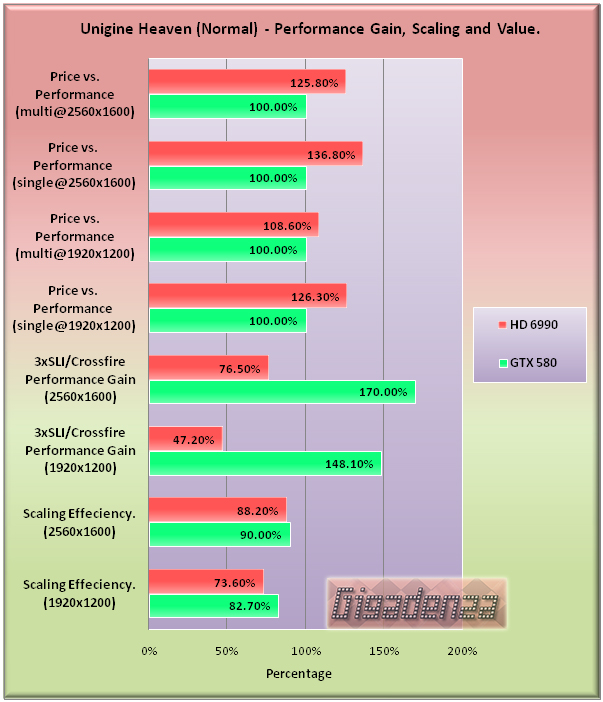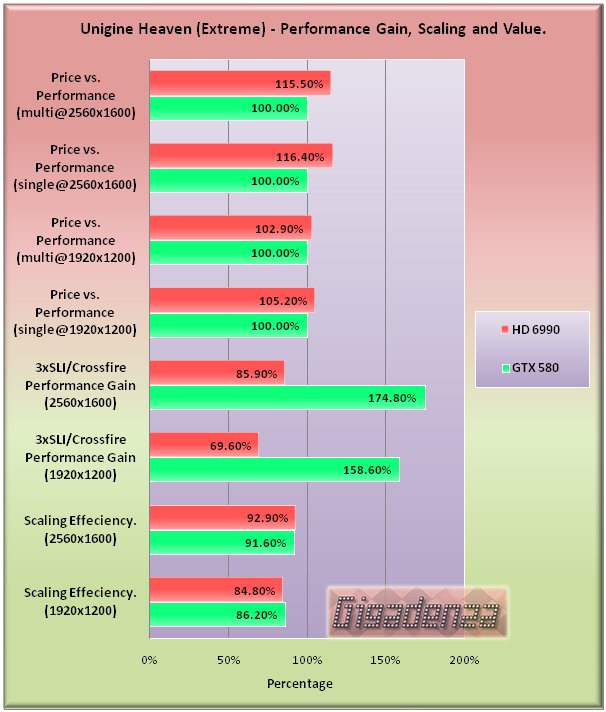HIS ATI Radeon HD 6990 Review. The Benchmarks.
Performance Analysis.


Glancing at the scaling results, we can promptly assert that even with normal tessellation, the Unigine benchmark provides more than enough obstacles for the cards to ensure they are not forming a disorderly queue behind the CPU!
The only slightly disappointing figure is the 47% increase yielded by the two 6990s at 1920×1200, though this still translates to a respectable scaling efficiency of 73.6%. The performance gain and scaling offered by our trio of 580s at the same resolution is more impressive, an increase of 148%, with each card flexing 82% of its muscles! At the higher resolution, ATI closes the gap. A healthy performance increase of 76% with a scaling efficiency of 88%, amongst the highest thus far for the red cards. Nvidia ups its game too, a gain of 170% in raw speed with each card just 10% shy of maximum efficiency.
Moving onto the extreme test, we witness a veritable scaling master class. At 1920×1200, adding a second 6990 provides a 69.6% performance gain while two additional 580s bring a further 158.6% of speed the party. These increases convert to equally impressive scaling with ATI now trailing Nvidia by a less than 2%. As if this weren’t enough, when switching to the higher resolution, the 580s raise the bar once more. A speed boost of 174.8% and scaling efficiency in excess of 90%. However, the 6990s turn in their best results of the entire review, an 85.9% performance bonus from a second card with both cards firing on 92.9% of their cylinders. This puts the red duo a shade ahead of Nvidia’s trio which, when considering the background of the Unigine benchmark and the 580s colossal scaling and tessellation powers, is an extremely significant victory.
When it comes to the question of value, it is ATI that achieves a clean sweep. The 6990’s advantage as a single card was substantial enough in both the normal and extreme tests to surge past the 25% target whilst the three 580s, despite winning the majority of tests in the multi-card battle, did not attain an overall lead greater than the magic 20%.
Conclusion.
In wrapping up this analysis it is important to reiterate its three objectives.
1. To establish which solutions provide the best raw performance irrespective of price
3. To compare the difference in raw performance of the solutions offered by both companies and use this data to find out which represents the best value.
3. To analyze the performance increase when running multiple video cards and assess whether the additional investment is worthwhile.
Raw Performance.
In singles competition, it’s no surprise that the 6990 emerges victorious since even the deposed 5970 was able to take the fight to a GTX 580 and score wins in numerous tests. Nevertheless, the subtle improvements ATI has made within its newly designed “Cayman” GPU combined with the notable addition of 2gb of video memory has ensured a far more decisive victory than many might have anticipated.
In the seven benchmarks we ran, there were 39 individual tests. For all but 3dMark, which provides its own score, victory was handed to the cards which achieved the highest average frame rate. In this case, the only time Nvidia got a look-in was during the Lost Planet 2 benchmark where the 580 briefly nosed ahead in two of the low resolution tests. For the remaining 6 benchmarks, which included 33 individual tests, ATI’s card dominated the proceedings.
Moving on to our multi-card comparison, we suspected things would be closer and were proven correct. Three 580s have already showcased their formidable powers against cross fired 5970s. But the big question posed at the start of this analysis was, would Ati’s drivers in harmony with the 6990s design enhancements and extra reserves of memory, allow it to apply itself more effectively in crossfire? In short…yes. The results for the Unigine benchmark alone are enough to confirm this.
Moreover, in Crysis Warhead, where two 5970s choked so badly amidst heavy eye-candy, a single 6990 is comfortably able to sustain fast and smooth frame rates . But how close would ATI get to Nvidia? Well, let’s look at the numbers. In the 39 tests we conducted, three 580s proved to be the winning formula for 33, while two 6990s managed just 6 victories. Nvidia therefore takes the performance crown though it should be noted, the 6990’s vastly improved performance and surprisingly efficient scaling made this battle hard fought.
Best value.
For our price vs. performance war, there were 15 separate results obtained from the seven benchmarks we ran and in 11 cases, the 6990’s winning margin in our singles face-off was greater than 25%, thereby justifying its higher price tag. Nvidia turned the tables on three occasions while one result provided us with a dead heat. To sum up, if you have the cash, the big red card is worth it!
Turning our attention to Crossfire and SLI. The 580s winning margin exceeded their target of 20% on just 4 occasions, for the remaining 11 tests, the 6990s were able to stay within range. Thus, Ati’s solution again represents better value, despite losing out in the performance stakes.
Worth it?
As to the question of whether or not either of these particular multi-card setups is worth the customers hard earned cash. In the real world and to the smart investor, the answer has to be no.
Put simply, an ideal scenario for most gaming enthusiasts will feature a resolution of at least 1920×1080 and consistently smooth frame rates that retain an average of above 30 frames per second. As was demonstrated in these tests, just one 6990 is more than capable of this, indeed even a single 580 only began to struggle during the Unigine benchmark and this was at the higher resolution of 2560×1600.
It is however, also fair to say that should money be of no concern, the acquisition of an extra card or two will certainly provide a substantial performance boost as well as broaden the enthusiast’s grin. Though many have stated multiple monitors are now essential to reap any benefit at all from configurations such as these, thanks to significant driver improvements by both ATI and Nvidia along with ever more demanding games and benchmarks, It is not difficult by applying a little eye candy to force these cards to sweat before the CPU becomes a limiting factor, they’ll merely be doing so at far higher frame rates than would be needed by most.




